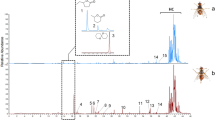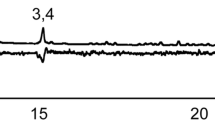Abstract
Ammonium acetate is a well-known and widely-used attractant, primarily as the main and essential component of the dry bait BioLure, in many fruit fly control systems. The integrated attractiveness of ammonium acetate and the attractiveness of its two volatile components were studied in laboratory experiments on both females and males of the Mediterranean fruit fly, Ceratitis capitata. Acetic acid was barely attractive for females and was very attractive for the males. Ammonia was significantly more attractive to females and the integrated attractiveness of ammonium acetate was higher for males than females.
Similar content being viewed by others
References
Bateman, M. A., & Morton, T. C. (1981). The importance of ammonia in proteinaceous attractants for fruit flies (family: Tephritidae). Australian Journal of Agricultural Research, 32, 883–903.
Buttery, R. G., Ling, L. C., Teranishi, R., & Mon, T. R. (1983). Insect attractants: Volatiles of hydrolyzed protein insect baits. Journal of Agricultural and Food Chemistry, 31, 689–692.
Dean, R. W. (1941). Attraction of Rhagoletis pomonella adults to protein baits. Journal of Economic Entomology, 34(1), 123.
Diaz-Fleischer, F., Arredondo, J., Flores, S., Montoya, P., & Aluja, M. (2009). There is no magic fruit fly trap: Multiple biological factors influence the response of adult Anastrepha ludens and Anastrepha obliqua (Diptera: Tephritidae) individuals to multilure traps baited with BioLure and NuLure. Journal of Economic Entomology, 102(1), 86–94.
Gothilf, S., & Galun, R. (1982). Olfactometer and trap for evaluating attractants for the Mediterranean fruit fly, Ceratitis capitata. Phytoparasitica, 10, 79–84.
Gothilf, S., & Levin, G. (1989). Attraction of the Mediterranean fruit fly to ammonium and protein bait. In R. Cavaloro (Ed.), Fruit flies of economic importance (pp. 387–391). Rotterdam: A. A. Balkema.
Gow, P. L. (1954). Proteinaceous bait for the oriental fruit fly. Journal of Economic Entomology, 47(1), 153–160.
Heath, R. R., Epsky, N. D., Guzman, A., Dueben, B. D., Manukian, A., & Meyer, W. L. (1995). Development of a dry plastic insect trap with food-based synthetic attractant for the Mediterranean and Mexican fruit flies (Diptera: Tephritidae). Journal of Economic Entomology, 88(5), 1307–1315.
Heath, R. R., Epsky, N. D., Midgarden, D., & Katsoyannos, B. I. (2004). Efficacy of 1,4-diaminobutane (putrescine) in a food-based synthetic attractant for capture of Mediterranean and Mexican fruit flies (Diptera: Tephritidae). Journal of Economic Entomology, 97(3), 1126–1131.
Keiser, I., Jacobson, M., Nakagawa, S., Miyhashita, D. H., & Harris, E. J. (1976). Mediterranean fruit fly: Attraction of females to acetic acid and acetic anhydride, to two chemical intermediates in the manufacture of cue-lure, and decaying Hawaiian tephritids. Journal of Economic Entomology, 69(4), 517–520.
Lasa, R., & Cruz, A. (1914). Efficacy of new commercial traps and the lure Ceratrap® against Anastrepha obliqua (Diptera: Tephritidae). Florida Entomologist, 97(4), 1369–1377.
Leblanc, L., Vargas, R. I., & Rubinoff, D. (2010). Attraction of Ceratitis capitata (Diptera: Tephritidae) and endemic and introduced nontarget insects to BioLure bait and its individual components in Hawaii. Environmental Entomology, 39(3), 989–998.
Matsumoto, K. E., Buttery, R. G., Flath, R. A., Mon, T. R., & Teranishi, R. (1985). Protein hydrolysates volatiles as insect attractants. ACS Symposium Series, 276, 353–366.
Mazor, M. (2009). Competitiveness of fertilizers with proteinaceous baits applied in Mediterranean fruit fly, Ceratitis capitata Wied. (Diptera: Tephritidae) control. Crop Protection, 28, 314–318.
Mazor, M., Gothilf, S., & Galun, R. (1987). The role of ammonia in the attraction of females of the Mediterranean fruit fly to protein hydrolysate. Entomologia Experimentalis et Applicata, 43, 25–29.
Mazor, M., Peysakhis, A., & Reuven, G. (2002). The rate of release of ammonia – The key component in the attraction of female Mediterranean fruit fly to food lures. IOBC/WPRS Bulletin, 25(9), 323–329.
McPhail, M. (1939). Protein lures for fruit flies. Journal of Economic Entomology, 32(6), 758–761.
Morton, T. C., & Bateman, M. A. (1981). Chemical studies on proteinaceous attractants for fruit flies, including the identification of volatile constituents. Australian Journal of Agricultural Research, 32, 905–916.
Robacker, D. C., & Flath, R. A. (1995). Attractants from Staphylococcus aureus cultures for Mexican fruit fly, Anastrepha ludens. Journal of Chemical Ecology, 21(11), 1861–1874.
Robacker, D. C., Warfield, W. C., & Albach, R. F. (1993). Partial characterization and HPLC isolation of bacteria-produced attractants for the Mexican fruit fly, Anastrepha ludens. Journal of Chemical Ecology, 19, 543–557.
Robacker, D. C., Moreno, D. S., & DeMilo, A. B. (1996). Attractiveness to Mexican fruit flies of combinations of acetic acid with ammonium/amino attractants with emphasis on effects of hunger. Journal of Chemical Ecology, 22(3), 499–511.
Robacker, D. C., Martinez, A. J., Garcia, J. A., & Bartelt, R. J. (1998). Volatiles attractive to the Mexican fruit fly (Diptera: Tephritidae) from eleven bacteria taxa. Florida Entomologist, 81(4), 497–508.
Steiner, L. F., Mitchell, W. C., & Ohinata, K. (1958). Fruit fly control with poisoned-bait sprays in Hawaii. USDA Agricultural Research Service, 1–4.
Teranishi, R., Buttery, R. G., & Mon, R. (1985). Steam distillation-extraction isolation of insect attractive volatiles from protein hydrolysates. In T. E. Acree & D. M. Soderland (Eds.), Semiochemistry: Flavours and pheromones (pp. 169–180). Berlin: Walter de Gryter.
Wakabayashi, N., & Cunningham, R. T. (1991). Four-component synthetic food bait for attracting both sexes of the melon fly (Diptera: Tephritidae). Journal of Chemical Ecology, 84, 1672–1676.
White, I. M., Elson-Harris, M. M., 1994. Mediterranean fruit fly. In: Fruit Flies of Economic Significance: their Identification and Bionomics. CAB International, Oxon, U.K., pp. 291–298.
Acknowledgments
I wish to thank Alexander Peysakhis for his supportive technical assistance, to Ruth Akiva from the Israel Cohen Institute for Biological Control in the Plants Production & Marketing Board who is always ready to provide me flies for the experiments, to Hagit Baram who helped me with the statistical analyses and to Prof. Rachel Galun, my friend and mentor, for her valuable comments on previous drafts of this manuscript.
Author information
Authors and Affiliations
Corresponding author
Rights and permissions
About this article
Cite this article
Mazor, M. The role of acetic acid in the attraction of the Mediterranean fruit fly Ceratitis capitata to ammonium acetate. Phytoparasitica 46, 377–381 (2018). https://doi.org/10.1007/s12600-018-0666-6
Received:
Accepted:
Published:
Issue Date:
DOI: https://doi.org/10.1007/s12600-018-0666-6




